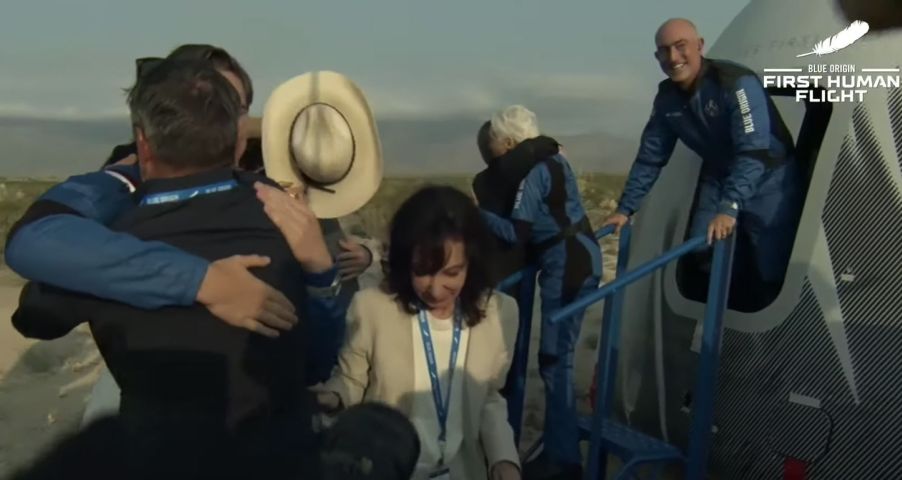
Amazon’s Jeff Bezos Beat Tesla’s Elon Musk to Space, but What’s Next?
July 2021 saw three multi-billionaires engaged in a friendly competition to reach outer space. The knighted founder of the Virgin Group was the first to achieve such lofty heights, with the CEO of Amazon following shortly thereafter. How and why did Richard Branson and Jeff Bezos beat Tesla‘s Elon Musk to space?
Rich guys race to space

Jeffrey Preston Bezos invented a little online bookstore called Amazon in his Seattle garage in 1994. Today, Investopedia rightly refers to him as the wealthiest man on Earth. So, what does a rich guy do for thrills once he’s invested in everything from Airbnb to Twitter and owns the Washington Post? They start a private spaceship company.
Bezos’ private space tourism company, Blue Origin, was founded at the turn of the 21st century, beating Elon Musk’s SpaceX by two years and Branson’s Virgin Galactic by four. Astronomy magazine explains that the 57-year-old entrepreneur held a deep interest in space flight since he was a little kid. Still, it wasn’t until he amassed an astronomical personal fortune that he could afford to live out such a big dream.
Aiming for the stars
Named for the moon that orbits Pluto, Charon was the first test vehicle launched by Bezos’ nascent space tourism company. Powered by four Rolls Royce Viper Mk.301 jet engines, the low-altitude vehicle attained an elevation of 316 feet on March 5, 2005, and now resides in Seattle’s Museum of Flight.
UK Today News reports, Blue Origin’s first successful peroxide-powered suborbital craft was named in honor of rocket pioneer Robert Goddard and was the first test vehicle developed in anticipation of Bezos’ New Shepard program.
Before shuttling Bezos and the crew to the edge of the atmosphere and back, Various iterations of New Shepard launched and landed more than a dozen times without anyone on board.
On July 20, the first crewed New Shepard mission carried Bezos, his brother, Mark, a Dutch high school graduate named Oliver Daemen, and NASA veteran, Mary Wallace “Wally” Funk, a remarkable 82 years old at the time of the flight.
The crew capsule detached, allowing the space riders to soar to a peak altitude of 66.5 miles above the Earth after attaining a maximum ascent velocity of 2,223 mph. The entire mission was clocked at 10 minutes and 10 seconds by Barron. The journey wasn’t quite long enough for Funk, who landed and said, “It was only about five minutes!”
As amazing as it was, Bezos’ high-flying trip was not the first private space flight enjoyed by a wealthy entrepreneur. Sir Richard Branson’s rocket ride to space also began with a childhood dream. Dubbed SpaceShipTwo, the supersonic, suborbital craft, zoomed him, two pilots, and three Virgin Galactic mission specialists into space on July 12, 2021. Spaceflight Insider states that it took nearly two decades to develop.
On July 11, Richard Branson, two pilots, and three Virgin employees hurtled to the edge of space aboard Virgin Galactic’s SpaceShipTwo. While thoroughly enjoying a few minutes of weightlessness, Branson exclaimed:
“To all you kids out there—I was once a child with a dream, looking up to the stars. Now I’m an adult in a spaceship. If we can do this, just imagine what you can do!”
He’s no kid, but Elon Musk took Branson’s invitation to heart
Tesla founder Elon Musk’s SpaceX focuses primarily on delivering satellites into orbit as it plans payloads to Mars, the International Space Station, and other celestial destinations. Virgin Galactic is all about taking people for the ride of their lives.
According to EarthSky, Musk has already plunked down a $10,000 deposit for a future spaceflight aboard a Virgin Galactic craft. When he’ll take off is anyone’s guess, but we’ll wish him a hearty “Bon voyage!’ when he does.


